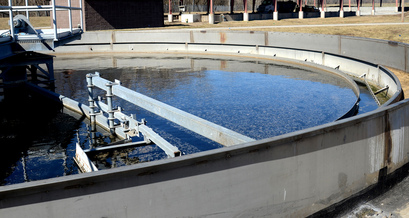
First floating sludge is most often caused by:
- Denitrification – small nitrogen gas bubbles float the sludge in the clarifier creating floating sludge chunks with small bubbles entrapped
- Fats, Oils & Grease – simply put, FOG floats on water. When entrapped in floc, excessive grease or oil can cause floating biomass. This appears as a scum blanket that can cover the entire clarifier.
- Viscous bulking or billowing sludge – viscous bulking can sometimes create floating sludge (more often it is just billowing over the weir versus floating). This is often caused by nutrient deficiencies (normally low phosphate) in industrial waters.
Solutions to floating sludge:
- Denitrification problems can be often controlled by increasing the recycle pump to reduce sludge blanket depth/sludge retention time in the clarifier. The problem is often related to an increase in influent ammonia/nitrogen that is converted by beneficial nitrifiers into NO2 or NO3 via the autotrophic nitrification process. Without an anaerobic/anoxic step that removes NO2 or NO3 in the treatment system, this process occurs in the clarifier. Long run solutions include evaluating influent TKN/ammonia, anoxic denitrification zone residence time, availability of “food” or easily available BOD in the anoxic zone for denitficiation, and an overall system survey on sludge age, residence times, and influent makeup.
- Fats, Oils & Grease – FOG created floating sludge involves a messy control process. First the scum/floating sludge needs to be removed or allowed to carry over the weir to polishing/tertiary treatment. Upstream, operators need to evaluate where the FOG increase originated. This can be a one-time slug or increased loadings of grease over time. It is best to prevent oils and grease from entering the biological treatment system. In cases where we have high levels of FOG in a system we encourage operators to increase wasting rates (remove entrapped FOG this way) and add cultures associated with FOG degradation/biosurfactant production. By using wasting and seeding steps together, the potential for significant biomass reduction is prevented while removing entrapped FOG that causes high effluent solids.
- Viscous Bulking – solution here is to evaluate changes in influent makeup and changes in the environmental conditions in the biological treatment unit. While researching the exact cause of the bulking, operators need to begin wasting the bulking, viscous sludge. If nutrient residuals are low (<1.0 mg/L ammonia nitrogen or <0.5 mg/L ortho-phosphate) then begin adding nutrients to achieve residuals above the targets above. If heavy wasting is involved, we recommend adding cultures to promote the shift to a desirable biomass.

 RSS Feed
RSS Feed